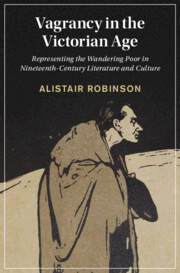 Vagrancy in the Victorian Age
Vagrancy in the Victorian Age from Part II - The City
Published online by Cambridge University Press: 02 November 2021
London was a centre of vagrancy in the Victorian period. Its refuges, lodging-houses and workhouses ensured that large numbers of vagrants travelled to the capital, especially during the winter months when travelling on the open road could be difficult and dangerous. The first half of this chapter examines how these forms of relief structured the vagrants’ movement and resulted in what I call ‘metropolitan vagrancy’. This was a constrained form of movement, typically limited to the winter months, that was contoured by the resources that the vagrant poor were able to access and the mounting restrictions that were placed on them by the Poor Law. The second half examines an understudied depiction of homelessness that was, in part, a product of these restrictions: the queue outside the ‘casual’ or vagrant ward of the workhouse. This became an image that articulated anxieties about the difficult distinction between the deserving and undeserving poor, and also conveyed fears about the illiberality of the Poor Law and the potentially revolutionary response that it might provoke. This chapter examines works by Charles Dickens, Charles Kingsley and the painter Luke Fildes.
To save this book to your Kindle, first ensure no-reply@cambridge.org is added to your Approved Personal Document E-mail List under your Personal Document Settings on the Manage Your Content and Devices page of your Amazon account. Then enter the ‘name’ part of your Kindle email address below. Find out more about saving to your Kindle.
Note you can select to save to either the @free.kindle.com or @kindle.com variations. ‘@free.kindle.com’ emails are free but can only be saved to your device when it is connected to wi-fi. ‘@kindle.com’ emails can be delivered even when you are not connected to wi-fi, but note that service fees apply.
Find out more about the Kindle Personal Document Service.
To save content items to your account, please confirm that you agree to abide by our usage policies. If this is the first time you use this feature, you will be asked to authorise Cambridge Core to connect with your account. Find out more about saving content to Dropbox.
To save content items to your account, please confirm that you agree to abide by our usage policies. If this is the first time you use this feature, you will be asked to authorise Cambridge Core to connect with your account. Find out more about saving content to Google Drive.